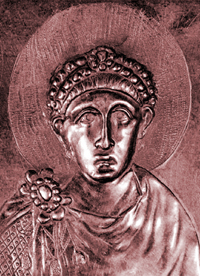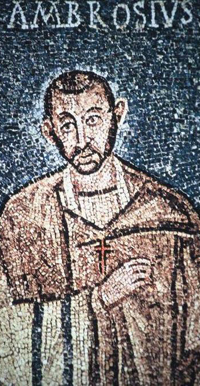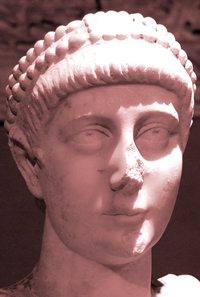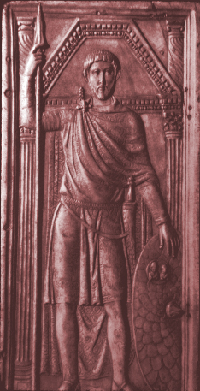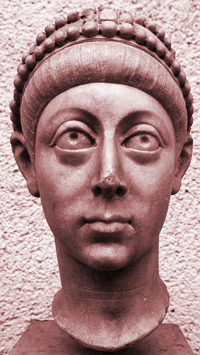
AE3 - IMP THEODOSIUS I
(RIC IX 18c 17)
- Cyzicus Mint
Flavius Theodosius
Born: 347
Caesar: A.D. 378-395
Obverse: Portrait diademed, draped, cuirassed bust right - DN THEODOSIVS PF AVG
Reverse: Helemted Roma seated, right leg bare, looking right holding spear and globe - CONCORDIA AVGGG - SMKG
|
Inscriptions: D(ominus) N(oster) THEODOSIVS P(ius) F(elix) AVG(ustus) / CONCORDIA (Harmony) AVG(ustus) GG (the Romans) - SMKG (Cyzicus Mint) Our Lord Theodosius Pious and Happy Augustus / Harmony between the Augustii (three emperors) - Minted in Cyzicus The triple 'G' in 'AVGGG' denotes he is one of three co-rulers. This means this coin was minted within the five year period, after August 378 and before August of 383, when he was eastern co-ruler with Gratian and Valentinian in the west. This coin is announcing harmony between these three rulers. Theodosius was born in 347, at or around Cauca or Italica in Spain. His mother was named Thermantia and his father was the high ranking general Flavius Theodosius (the elder), also known as Count Theodosius as he achieved the rank of Comes Britanniarum or Count of the Province of Britain. His father led successful campaigns in Germany against the Alemanni and suppressed a rebellion in Mauretania. Most importantly he was put in command of Roman forces in Britain in 367 during what is known as the 'Great Conspiracy'. The so called barbarica conspiratio was a concentrated effort by the Picts from Caledonia, the Scotti and Attacotti from Hibernia, and Germanic Franks and Saxons to take advantage of an increasingly weakening and undermanned Roman Empire and over run its territory in Britain and northern Gaul. Roman troops garrisoned on Hadrian's wall rebelled and allowed these incursions to take place. After repeated failures by other commanders to bring this situation under control, the elder Theodosius was sent to Britain with a relief force by the emperor Valentinian I. He used a mixture of force, negotiation, clemency and concessions to quell the uprising. By 368 the invaders had been driven from Roman territory and a semblance of order was returned. The Elder Theodosius returned to a hero's welcome and to serve as a top military commander under Valentinian as magister equitum praesentalis (Master of Horse close to the emperor). The younger Theodosius followed his father into the military and is said to have accompanied his father to Britain along with the future usurper Magnus Maximus. Like his father he seemed to prosper and by 374, the younger Theodosius had risen to become the Dux Moesiae Primae (First Commander of the Legion Moesia). They both would soon be knocked from their perch by the emperor Valentinian under mysterious circumstances. Some time in early 375 Theodosius was apparently forced into retirement and the elder Theodosius was executed by order of the emperor Valentinian. The exact reasons for his fathers execution and his own retirement are not clear but hardly out of the ordinary given their station and the emperor they served. Valentinian was known for his volatile, fierce, and often deadly temper towards those who angered him. Sources clearly illustrate his habit of losing his temper, yelling, and harsh punishment. He is even said to have died after suffering from a stroke during a violent rage. Valentinian was said to have issued severe punishment to those he saw as being responsible for a military defeat. It is possible Theodosius and his father were being blamed and punished for a defeat they suffered against a force Sarmatians in late 374. Regardless of the the reasons, by 375 the elder Theodosius was dead and the younger Theodosius had retired to his home in Spain. The younger Theodosius would not be retired for long. By late 375 the Emperor Valentinian was dead and Theodosius was soon after recalled to service by Gratian, Valentinian's son and successor in the west. He probably served Gratian first as Dux Valeriae and then as magister militum per Illyricum where he again clashed with Sarmatians. Theodosius was certainly in good standing with Gratian when Valens, uncle to Gratian and his colleague in the east, died at the battle of Adrianople on August 9, 378. Not long before, Theodosius was facing forced retirements and his father was executed, now he was being named as Valens successor. An emperor had fallen in battle, a grave set back in what would become known as the Gothic wars. A period of time roughly between 376 and 382 AD where there was a mass migration of Gothic tribes who had been displaced by Huns. These tribes sought asylum in Roman territory which was granted but rendered quite harshly. Due to severe conditions, starvation, and mistreatment these tribes instead took to plundering roman territory. This was not going to go away and Theodosius would now be expected to pick up the pieces and rebuild the shattered armies of the east. Theodosius became the Emperor in the East in early 379 and the young Gratian co-ruled the west with his even younger half brother Valentinian II. Gratian was around 20 years old when he appointed Theodosius emperor in the east, Valentinian II was about 8. The two western emperors were both very young and inexperienced as opposed to Theodosius who was older as well as a veteran soldier and commander. The west was divided between the two young emperors with Gratian the senior of the two. Valentinian II was just a child, a figurehead, in the care of and guided by his mother and powerful military and religious factions. Having been raised in the imperial family, Gratian was well educated in both letters and war having taken the field with his father at a very young age. He was well groomed but apparently ineffectual and easily manipulated by his generals and council who were quite possibly the ones behind the choice to raise Theodosius in the east. There were serious threats which needed immediate attention. The imperial court in the west certainly recognized the need for a veteran general to quickly take action against the Goths who were now raiding into western territory. As a well born general with experience fighting against this enemy and with an intimate knowledge of the area, Theodosius was probably the best candidate for the task at hand. Gratian essentially handed over full control of all territories effected by Goth activity to Theodosius. The eastern armies were depleted from earlier losses and Theodosius was forced to rely heavily on newly recruited 'barbarian' troops combined with much smaller numbers of veteran troops. Gratian also sent aid in the form of troops and material support. In 379, forces under Theodosius would strike in Thrace gaining an early and promising victory in his renewed campaign against the Gothic tribes. Theodosius campaigned for most of 380. Many of his new recruits lacked loyalty to Rome and deserted or traded sides. By late 380 Theodosius had suffered reverses. During the Autumn of this year Theodosius suffered from a life threatening illness and, fearing he would die, was baptized by Bishop Acholius of Thessalonica. At this time it was customary to receive baptism when one was close to death. Theodosius soon recovered from his illness and requested aid from the west. In answer to his request, Gratian sent troops and joined Theodosius to help bolster the struggling eastern forces. Soon after this Theodosius retired to Constantinople entering that city for the first time in November 24th of 380. The combined forces of Theodosius and Gratian succeeded in retaking Illyricum from the Goths in early 381. Theodosius accepted the surrender of the Gothic Chieftain Athanaric in January 11, 381 and came to terms with the remainder of the tribes by October 3, 382. These terms appear to have granted the Goth tribes the right to settle along the Danube and a degree of autonomy. Although many seem to have sought service in the Roman army they would, in general, lack loyalty to Rome and these semi independent tribes would continue to represent a threat to the security of the empire. Just days after entering Constantinople in late 380, Theodosius began to turn his attention to religious affairs. Theodosius was a Catholic Christian and he made it immediately clear that only the Catholic Christian faith would be acceptable. He expelled Demophilus, the Arian Bishop of Constantinople, and attempted to replace him with Gregory of Naziaznus, the leader of the local catholic community. In May of 381 he called a Synod of Catholic Bishops. This Synod, with the apparent approval of Theodosius, removed Gregory who was replaced by Nectarius, a prominent senator. His religious policy during the rest of his reign would see repeated instances of banishments and removals of 'heretical' bishops. At this time, the religious policies of Theodosius were most concerned with Christianity and the unification of that religion under one doctrine. He did little to further prohibit pagan worship early in his rule save to uphold earlier bans on blood sacrifice and harespices. There were still many pagans in powerful positions, too many pagans that could threaten his still somewhat fragile imperial standing. There seems to have been a problem enforcing these laws as he added that the failure to enforce laws pertaining to banned pagan practices would be an offense punishable by death. Theodosius sought to eliminate the Arian Christian sect and unify Rome and Christianity under the Nicene creed. He also sought to banish other religions or sects he saw as heretical or dangerous to the supremacy of Christianity. He renewed the persecution of those who followed Manichaeism. Manichaeism was an Eastern Gnostic religion which originated in Persia and had often been a target of both Persian and Roman imperial persecution. Theodosius issued several edicts against Manichaeism, outlawing the religion and punishing its followers with loss of rights, confiscation of possessions, banishment and death. All he deemed heretical was banished from the city of Constantinople in 284. Magnus Maximus was serving as Comes Britanniae and was in charge of the military forces in Britain when he was declared emperor by his troops in 383. Maximus possibly saw himself as a better candidate to serve as co ruler with Theodosius. The young western emperors were inexperienced and ineffective, unable to effect control but were instead controlled. Maximus was a very capable veteran soldier and general who had served under the elder Theodosius and at the side of the younger Theodosius. Maximus marched on Gaul, engaged and defeated Gratian who was in Paris. Gratian was said to have been betrayed by his troops in the end. He fled towards Rome but he was pursued and caught by Andragathius, Magister Equitum to Maximus, who killed him on August 25, 383 at Lyons. Theodosius and his remaining colleague in the west had a tenuous hold on imperial power. The death of Gratian left his colleague and brother, Valentinian II, the sole Augustus in the West. A mere twelve years old at the time, Valentinian II was just a child under the control of his family and generals. Theodosius named his young son Arcadias, little more than five years old, Augustus and nominally his co-ruler in the East. Maximus headed towards Rome but Theodosius was able to aid the young Valentinian II with troops enough to persuade Maximus to negotiate. Theodosius and Valentinian agreed to recognize Maximus as Augustus in the west to rule Britain, Gaul, Spain, and Africa if Maximus would agree not to advance against Valentinian who would continue to rule Italy. Maximus agreed, there would be peace between the two in the west. Maximus did not march on Rome but he named his infant son Victor as his co-Augustus and would never recognize Valentinian II as his legitimate colleague during his six year reign. During this uneasy truce, Valentinian in Italy became a buffer zone between Theodosius and Maximus. Theodosius took this time to strengthening his position. In 384 he traveled to Rome to meet with Valentinian and his generals. He sought and gained some measure of influence over the generals of Valentinian during this time. He also took steps to tie many of his own generals to his family by marriage thus cementing bonds and loyalty. Notably he married his niece Serena to his magister militum Stilicho in 385. In 386 Theodosius engaged Goths under Odotheus who were attempting to cross the Danube en force. His troops defeated and resettled them in Phrygia, he received a triumph for his efforts. Theodosius maintained relatively peaceful relations with Persia during most of his rule and would conclude negotiations with them in 387. The disputed territory of Armenia would be partitioned between two client kings, the Pro-Roman king Arsak in the west and the Pro-Persian king Khosro in the east. Possibly because of concerns over the growing influence Theodosius had over the young Valentinian II and the closeness of their families and courts, Maximus marched his forces into northern Italy and forced Valentinian and his family to retreat to Thessalonica where he sought refuge with Theodosius. Forces under Theodosius and those still loyal to Valentinian joined to oppose Maximus. Theodosius, whose first wife Aelia Flaccilla had recently passed away, wed Galla, sister to Valentinian II thus sealing their union in marriage before launching a joint offensive against Magnus Maximus in the summer of 388. Their forces and allies would claim a quick succession of early victories against Maximus in Sicily, Siscia and Poetovio forcing him to retreat across the alps. Maximus was eventually captured at Aquileia and executed on August 28, 388. His son Victor was captured and executed at Trier soon after. Valentinian II was now sole ruler of the Western Empire. After the defeat of Maximus, Theodosius and Valentinian retired to Milan. Theodosius would remain in Italy for several years. In 389 he visited Rome with Valentinian and his four year old son Honorius. It was round this time he unveiled new religious initiatives, one of which outlawed marriage between Christian and Jews. In 390 the people of Thessalonika rioted in opposition to the actions of Gothic troops garrisoned in the area leading to the death of the Garrison Commander. Infuriated, Theodosius retaliated by ordering his troops to take the city. The result was what would be known as the 'Massacre of Thessalonika' where troops under Theodosius killed a reported 7000 residents of the city. It was reported that after his initial rage, Theodosius rethought his decision and attempted to rescinded the order but they did not arrive in time to avert the massacre. For this act Theodosius was ex-communicated by Ambrose, the powerful bishop of Milan. Ambrose of Milan was one of the most important and influential figures in Christendom whose judgment held sway over Catholics and Theodosius who, by most accounts, was very religious. The fact that he ordered the powerful emperor to submit to months of penance before he could be readmitted, and that emperor obeyed, speaks volumes to the influence of the Bishop and the devotion of Theodosius to the Church. After this ordeal, Theodosius seemed more determined than ever before to ensure the dominance of Nicene Christianity. In 391, the eternal fire in the Temple of Vesta in the Roman Forum was extinguished, and the Vestal Virgins were disbanded on his orders. He also issued what is known as the 'Theodosian Decrees', a series of edicts against paganism. In these series of decrees he outlawed the use of all pagan rites in government and essentially outlawed all pagan practices in general. Pagan temples were subject to confiscation and destruction to make way for churches. Like the Alexandrian Temple of Serapis which was besieged and demolished by troops and zealous Christians, most temples across the empire would fall in a similar manner. By the end of 392, any practice linked to paganism as completely prohibited. The result of this was the almost complete repression of paganism and the dominance of Nicene Christianity as the only legal religion and the official religion of the Roman state. Theodosius returned to Constantinople in the summer of 391. With his absence, the already troubled relationship between the young Valentinian and his powerful and domineering Frankish general Arbogast quickly deteriorated. Arbogast commanded Valentinians forces against Maximus and was in almost sole command of western military forces which consisted mostly of Frankish and Gallic Troops. Valentinian was in a precarious position as his general was more powerful and influential than he. An emperor draws his power from his military and Valentinians military was loyal to Arbogast. When Arbogast refused to allow Valentinian to lead his troops to repel an incursion of barbarians into Italy, he was showing overt contempt for the young emperor. Valentinian attempted to relieve the general from his position but Arbogast simply refused to step down and did so in a very public way. The loyalty of troops working for Rome at this time were certainly fickle but In reality Arbogast was never loyal to Valentinian and Valentinian was never in control of Arbogast or the troops he commanded. Arbogast had only ever answered to Theodosius. Valentinians request to Theodosius for aid in bringing Arbogast under control came to late as Valentinian was found hanging in his residence at Vienne on May 15, 392. The official story was that the western emperor committed suicide but it is generally believed that Arbogast had him killed. Unfortunately for Arbogast, Valentinian was not just a colleague of Theodosius but also his brother-in-law and his wife Galla would not accept that her brother had committed suicide. Certainly the letter from the now deceased Valentinian requesting help in dealing with the insubordinate general did not help his cause. With few remaining advocates in the court of Theodosius, his attempts to communicate with the Eastern Augustus blocked, and little hope that he would not be held accountable for the death of Valentinian, Arbogast decided to take action before any condemnation could be passed down from the emperor in the east. Arbogast quickly secured most of Italy and hailed Eugenius, Master of the Secretariat (magister scrinii) under Valentinian, as the new western emperor on August 22, 392. Unlike with Maximus, a competent general with whom Theodosius had long known, respected, and served with, Eugenius was never accepted as legitimate by Theodosius. He refused to acknowledge Eugenius and instead raised his son Honorius as his colleague in early 393. Eugenius is often typified as being a supporter of the revival of Paganism with this being a possible source for the strict refusal of Theodosius to negotiate with him. Eugenius was a Christian but did, in his short time in power, lend some support to the restoration of certain Roman pagan temples and traditions which would certainly be a point of contention between he and Theodosius. In reality Theodosius saw Eugenius, and more so Arbogast, as threats who had murdered his puppet in the west. The resulting conflict would be more about power than any religious concerns. Theodosius refused any cooperation with Eugenius while preparing for the inevitable military conflict to remove the usurper. After about a year and a half of preparation, Theodosius and his armies marched west from Constantinople in May of 394. They marched unopposed through the Alps until they descended into the valley of the river Figidus west of Aquieia in early September. There they found the forces of Eugenius and Arbogast whom he wasted no time engaging. Theodosius attacked western forces on September 5, 394. The resulting conflict would be known as the Battle of the Frigidus River. Theodosius saw no success early in this battle which lasted two days. Employing mostly head on attacks by his Gothic troops, Theodosius suffered heavy loses which energized the forces of Arbogast and Eugenius who were said to have celebrated the days successes that night. Theodosius was understandably upset by the days events but his outlook suddenly changed upon receiving the news that a sizable contingent of soldiers from the west had defected to their side. The events of the next day must have seemed like the hand of God answering the prayers of Theodosius. During renewed offensives the next day, a torrential wind storm blew in from the east pushing on the backs of the Eastern troops and blowing sand into the faces of their enemies effecting their ability to fight. This is apparently a natural phenomenon that occurs in this area often referred to as 'Bora'. With help from the forces of nature and fickle loyalties, Theodosius defeated the western armies. Eugenius was captured and beheaded. Arbogast fled but soon realized he could not evade eventual capture and ended his own life. Theodosius was now the sole undisputed emperor of both the Eastern and Western Roman empire. This would be the last time East and West would be ruled by one emperor. If there was any chance paganism would again be tolerated under Eugenius and Arbogast, those hopes most certainly died that day. Theodosius fell ill and died in Milan on January 17, 395. Through his reign he made if very clear that he had dynastic ambitions. He had attempted to tie his principle military commanders to him through marriage and he had arranged for his sons to succeed him under these men's protection and guidance. Arcadius, the elder son at around 18 or 19, would rule in the East and Honorius, a child of about 6 years of age, would rule the West. Arcadius was put under the influence of the influential and ambitious Gaulish statesman Rufinus. The powerful general Stilicho was made guardian of Honorius. Although there was animosity between these two imperial guardians, in this way Theodosius was able to establish a short lived dynasty that would last for another 55 years. Theodosius and his dynastic successors would rule over an empire in the last throws of its decline. They are often credited with the acceptance, rise and domination of Nicene Christianity which would continue throughout the middle ages. Theodosian law is also often accredited as being the final death blow for paganism. Theodosius is generally thought to have been a devoted Christian who sought to unify the Roman empire under one faith and eliminate all others. Under him the Roman state adopted an official religion to the exclusion of all others. As religion blended with state restrictive and unprecedented laws were passed prohibiting everything from Homosexuality (which was punishable by death) to whom a Christian is allowed, and more importantly not allowed, to marry. The power of the Catholic church would continue to grow and dominate Europe and the East would become a Christian Empire. For his advancement of Christianity in the form of Catholicism, Theodosius was declared a saint. Theodosius also stands out as a life long competent soldier general turned Roman Emperor who was able to navigate and thrive in the increasingly tumultuous world of the (late) 4th and 5th century. He was a generals son and from his life in the military, and like his father before him fighting against and with the numerous and varied enemies and allies of the Empire, Theodosius became a highly experienced political and military leader. With a talent for mixing a little force with a little diplomacy, he often went to war with an enemy only to gain new allies as a result. In the end his biggest strength was simply his practical experience and familiarity with, those whom he fought or befriended. An understanding of the importance of relationships and the balance between diplomacy and war. |

